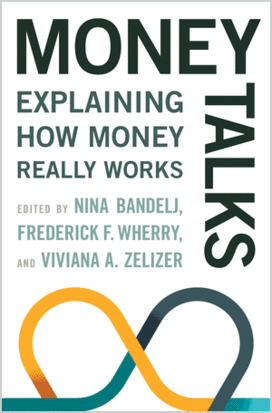The book: Bitcoin and Apple Pay are changing the way we use money, making it the perfect time to reexamine the how we think about currency. Money Talks: Explaining How Money Really Works analyzes an array of connections to show how social relations, emotions, morality, and institutions influence how we create and use money. This collection of essays from an interdisciplinary group of scholars brings together international experts — from economics to philosophy — to assess money’s history and future.
Money Talks asks five questions: How do social relationships, emotions, and morals shape how people account for and use their money? How do corporations infuse social meaning into their financing and investment practices? What are the historical, political, and social foundations of currencies? When does money become contested, and are there things money shouldn't buy? What is the impact of the new 21-century currencies on our social relations?
The authors: Nina Bandelj ’97 is a professor of sociology and a equity adviser to the dean of social sciences at the University of California, Irvine. Frederick F. Wherry *04 is a professor of sociology at Princeton. Viviana A. Zelizer is the Lloyd Cotsen '50 Professor of Sociology at Princeton.
Opening lines: Money mesmerizes and mystifies. Its influence extends far beyond the steely confines of numbers, ledgers, and rational calculations. Yet, for a long time, economists managed to keep monetary analysis safely constrained within technical territory. Coinciding with Gertrude Stein’s sober dictum that “whether you like it or whether you do not, money is money and that is all there is about it,” economic analyses demystified money’s range. They did so by certifying that a dollar is a dollar, no matter how it is earned, who earns it, or how it is spent. In short, when it behaved, money functioned as an impersonal medium of exchange and, therefore, could move efficiently.
But money has been escaping its narrow domain. At the start of the twenty-first century, novel investigations challenge and reshape our understandings of how money works. Breaking down artificial barriers between the worlds of money and social life, analysts from multiple disciplines document money’s integration into the spheres of interpersonal relations, cultural practices, moral concerns, legal regulation, historical variation, religious meaning, and political disputes. Within economics itself, new analyses of money have reshaped the conversation. Most notably, the influential mental accounting theory developed in the late 1970s to early 1980s by Richard Thaler, Daniel Kahneman, and Amos Tversky, redirected economic thinking about money by introducing unexpected evidence about monetary differentiation.
Monetary innovations transcend academia. In recent years, the surge of new currencies and payment systems has transformed how we use money and how we think about it. Along with cash, credit cards, debit cards, and checks, we can now pay with Square, Google Wallet, Apple Pay, Venmo, as well as with a multiplying set of cryptocurrencies, most notably Bitcoin. Or consider how m-pesa, the mobile phone–based money transfer service, has opened up a crucial new form of payment for people in developing economies. And around the world, emerging local currency communities, barter arrangements, and other peer economies further broaden forms of exchange and payment. Meanwhile, leading economist Kenneth Rogoff in his The Curse of Cash (2016) advocates doing away with paper money.
Reviews: Rebecca Spang, of the Financial Times, says, "The book’s central message — that the management and regulation of money should not be left to economists or bankers alone — is one we should all take to heart."















No responses yet